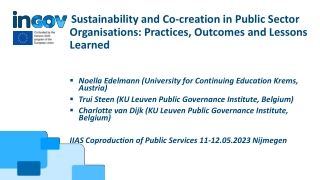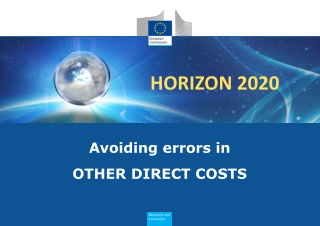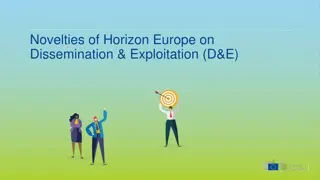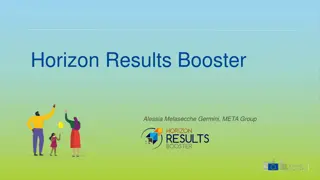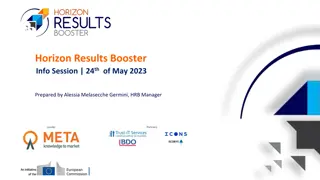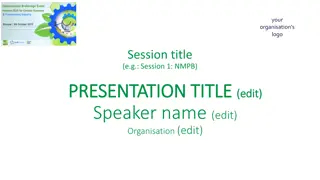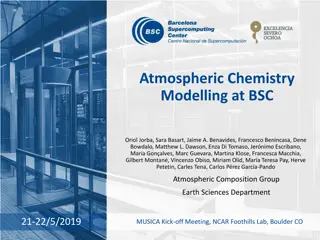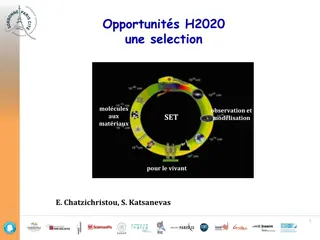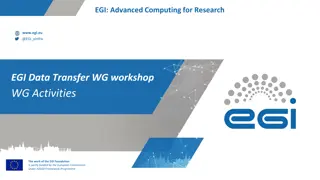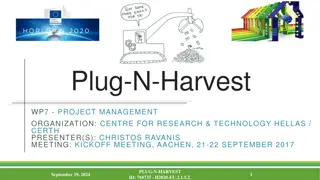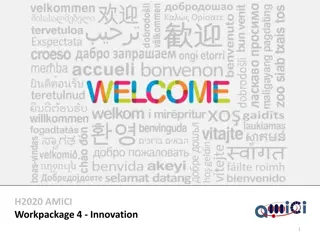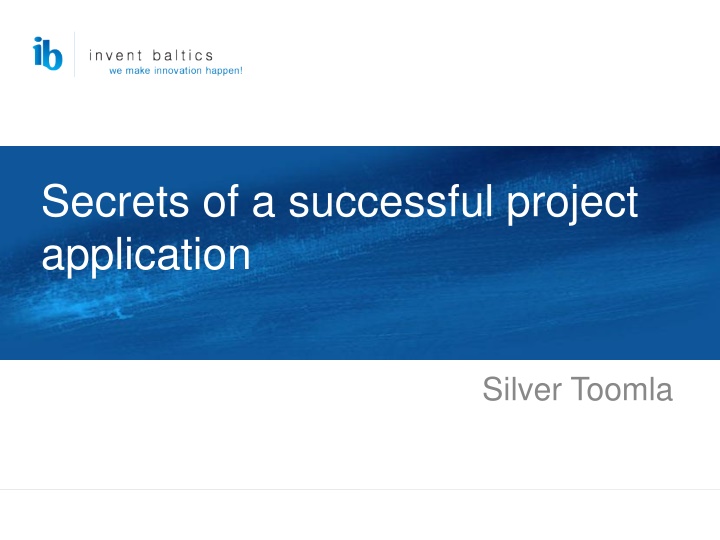
Successful Project Application Strategies and Funding Essentials
Discover the secrets of a successful project application along with Technology Readiness Levels (TRL), project types, funding opportunities, and outcomes. Learn about different funding instruments, expected outcomes, and how to navigate through various research and innovation actions. Explore opportunities for collaborations, sector analyses, and R&D cooperation to enhance your project's success.
Download Presentation

Please find below an Image/Link to download the presentation.
The content on the website is provided AS IS for your information and personal use only. It may not be sold, licensed, or shared on other websites without obtaining consent from the author. If you encounter any issues during the download, it is possible that the publisher has removed the file from their server.
You are allowed to download the files provided on this website for personal or commercial use, subject to the condition that they are used lawfully. All files are the property of their respective owners.
The content on the website is provided AS IS for your information and personal use only. It may not be sold, licensed, or shared on other websites without obtaining consent from the author.
E N D
Presentation Transcript
Secrets of a successful project application Silver Toomla
Technology readiness level TRL 1 basic principles observed TRL 2 technology concept formulated TRL 3 experimental proof of concept TRL 4 technology validated in lab TRL 5 technology validated in relevant environment (industrially relevant environment in the case of key enabling technologies) TRL 6 technology demonstrated in relevant environment (industrially relevant environment in the case of key enabling technologies) TRL 7 system prototype demonstration in operational environment TRL 8 system complete and qualified TRL 9 actual system proven in operational environment
Project types funding and outcomes Project type Funding instrument Funding rate Expected outcome Research and Innovation actions (applied research) Collaboration projects (one phase submission / two phase submission) Up to 100 % (25 % flat overhead) TRL 3 experimental proof of concept TRL 4 technology validated in lab TRL 5 technology validated in relevant environment Innovation Actions (close to market research and product development) SME Instrument Collaboration projects 70-100% (25 % flat overhead) TRL 7 system prototype demonstration in operational environment TRL 8 system complete and qualified TRL 9 actual system proven in operational environment Coordination and support actions Coordination / support Up to 100 % (25 % flat overhead) Sector analyses; R&D cooperation
Project types funding and outcomes Project type Funding instrument Funding rate Expected outcome Marie Curie Actions (mobility) Research Training Networks RISE Individual Fellowships Up to 100 % (25 % flat overhead) Development of research careers; Academia-industry cooperation Research cooperation networks Research Capacity building New research centers Capacity Building projects ERA Chair Twinning Teaming Up to 100 % (25 % flat overhead)
ERA Chair Competitive research environment through hiring ERA Chair and associated research team (full-time) Research capacity building ERA Chair + research team Establish research management principles; Sustainability plan and Smart specialisation strategies; Training (inc. soft skills). EU contribution: 2.5 MEUR for 5 years (41 600 EUR per 1 month) Mono-beneficiary Deadline: 05 October 2017 Read more: ec.europa.eu/research/participants/portal/desktop/en/opportuniti es/h2020/topics/widespread-03-2017.html
TWINNING Enhance the S&T capacity and raise the research profile Short term staff exchanges; Expert visits and short-term on-site or virtual training; Workshops and conference attendance; Joint summer schools; Dissemination and outreach activities. EU contribution: 1 MEUR for 3 years 3 partners: 1 from widening country, 2 internationally-leading partners at EU level Deadline: 15 November 2017 Read more: ec.europa.eu/research/participants/portal/desktop/en/opportunities/h2020/topics/widespread-05- 2017.html
SME Instrument product development / Commercialization
The game has changed The goals is to have real solutions for industry not only advance the state of the art in research Innovation actions and applied research projects the starting point for innovation action projects is validated proof of concept or a functioning prototype. Stronger lead from SMEs and large companies (coordination) Continuation of a research project with a new research project is a bad idea
Success criteria's Know your topic! Novel technological solution (beyond state of the art) and a strong demand from industry- WOW effect Check previously funded projects Understand the criteria's of the call research and innovation action vs innovation action Novel scientific methodology to achieve the goals Do not start from TRL level 1 show a validated concept to back your research methodology
Success criteria's background + outcome Explain the need for the project/solution (rationale) Current status problem description Alternative solutions Timing why now Explain the project outcome in measurable way Benefits of the solution compared to existing ones Novel research methodology The outcome has to be explained from the industry/end-user perspective with concrete use cases Do not start the project with objective description!
Success criteria's - consortium Strong consortium and larger industry participation (depending from the call) Innovation actions should be coordinated by industry Strong names bring better grades Stronger focus on commercialization presenting the business perspective not technology alone set-up for consortium Impact expectations outlined in the call set-up for consortium Ability of the consortium to utilize the research results consortium quality will affect the impact!
Success criteria's objectives and workplan The project objectives and results have to be presented in a measurable way concrete parameters and characteristics. Clear and well presented work plan Justification of methodology detailed task descriptions, clear roles of partners clear starting point and outcome on WP level Consortium has to cover the required competence! Detailed and well explained budget do not overblow the budget! Scientific partners always bluff the budgets!
Success criteria's impact + uptake of project results Follow the impact listed in the workplan + modifications Progress beyond state of the art Well explained application areas and commercialization plan how are the research results developed further and by whom. Stronger focus on commercialization presenting the business perspective not technology alone Dissemination/communication WP cannot be just a template application specific with concrete outcomes and measurable objectives Ability of the consortium to utilize the research results.
Success criteria's easy to read Structure the text and outline core evaluation criteria's Document has to be easily readable Include graphics and drawings Start a chapter with core points and then explain them in more detail Make cross references to other chapters. Make life easier for the evaluator
Success criteria's organize the writing process Start early 6-8 month before the submission deadline Start with consortium building and formulate the core team as quickly as possible Large companies take time to decide (management procedures) one of the core reasons to start early Strong coordinator (knowing the topic) is an absolute must! Present a clear methodology and work plan set-up Organize the writing process clear task distribution and timing WP leaders
Thank you! Silver Toomla silver.toomla@invent.ee Invent Baltics O www.invent.ee http://enterprise-europe.ee


